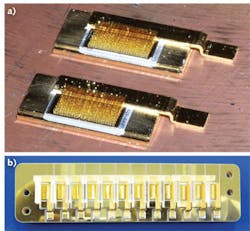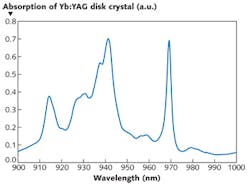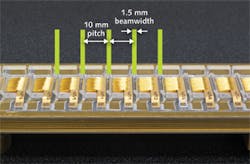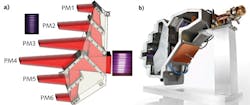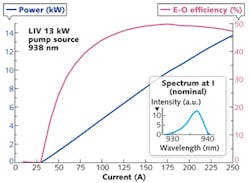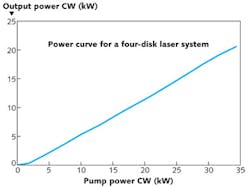ROBERT ROFF, VIOREL NEGOITA, HAIYAN AN, THILO VETHAKE, STEFAN HEINEMANN, GEORG TREUSCH, and TINA GOTTWALD
Diode-pumped solid-state lasers (DPSSLs) are established tools in many industries based on their low cost of ownership, high efficiency, and high reliability. As beam quality and power improved, DPSSLs also made inroads into the laser cutting market, replacing CO2 lasers. Recent advances enable power scaling to several tens of kilowatts continuous-wave (CW), which make a wide range of applications possible, from material processing to airborne defense systems. Cold, high-precision processing with ultrashort pulsed lasers further accelerates the market penetration of DPSSLs.
Disk lasers and fiber lasers are the two predominant DPSSL designs. A fiber laser is designed with a fiber-optic cable, typically with a 0.3 mm diameter and 30 m in length, serving as the laser resonator, while disk lasers use a thin disk with a typical diameter of 10 mm and a thickness of less than 1 mm as the laser resonator. Both designs mitigate thermal lensing through efficient heat removal, which is essential for high beam quality and high power.
The requirements for pump diodes are quite different for each design based on the specific dimensions of the laser resonator. Fiber lasers require high-brightness diodes with a beam quality of less than 90 mm*mrad to couple into the small diameter fiber. The pump radiation is absorbed over the length of the fiber. Disk lasers are pumped with a typical beam quality of 450 mm*mrad. Multiple paths through the thin disk are required for efficient absorption. Achieving brightness and power scaling of pump diodes that balance performance with cost has been a challenging engineering task for decades.
Both laser systems use a ytterbium (Yb)-doped active laser medium that demonstrates a broad absorption peak around 940 nm and a narrow absorption peak around 970 nm. The exact wavelengths depend on the specific laser design—a typical absorption spectrum of a ytterbium: yttrium aluminum garnet (Yb:YAG) disk laser is shown in Fig. 1. The broad absorption spectrum is centered at approximately 937 nm and, based on a 90% width of ~8 nm, the diode wavelength is easily matched. For high beam quality at high power and short pulses, a low quantum defect and short resonator are essential. This is achieved by pumping at 969 nm; however, the narrow pump band with a 90% width of approximately 1 nm requires wavelength-stabilized pump modules.Modules for pumping
High-power laser diode modules with power up to 12 kW CW are now available for optical pumping of thin disk lasers.1-3 This family of pump modules is based on a novel platform that solves most, if not all, of the problems associated with traditional microchannel cooler stacks. Traditional microchannel coolers are designed to have both electric current and cooling water flow through and around the copper cooling channels with no isolation between them. This design sets up an electro-corrosion effect that occurs near the inlet and outlet O-ring seals and can lead to early failure (water leaks).
For power scaling, individual coolers are stacked with O-rings in between, leading to very compact and high-power pump modules. However, the issues of electro-corrosion, leaking O-rings, and limited beam quality remain. The platform design employs an aluminum nitride (AlN) layer with structured metallization in the cooler that serves as the common mounting base for multiple diode lasers. It also effectively isolates the electric current from the water and enables hermetic sealing such that the water is contained in one monolithic cooler structure.
The laser bar incorporates single-quantum-well indium gallium arsenide (InGaAs)/aluminum gallium arsenide (AlGaAs) grown by MOCVD and is optimized for low internal loss, high power conversion efficiency (PCE), and low divergence in both axes. The laser bar with dimensions of 10 × 4 mm has 55 emitters and a fill factor of 55%. The packaging technology is optimized for high reliability at high output power, and low smile for good beam quality.
The bar is mounted to an expansion-matched CuW submount with hard-solder gold tin (AuSn) to eliminate solder creep, which appears when soft, solder-like indium (In) is used. Alignment of the laser front facet to the submount is critical for good heat-sinking and to avoid disturbing the emission of the laser. Five-axis alignment is used to position the laser to the submount and to level the laser to the solder interface for a void-free solder joint.
Bonding parameters were developed to induce solder to wet up to the front facet, providing for good thermal contact. Careful control of bond tool surface specification and cleanliness yield a typical smile for this assembly of less than 1.5 μm. Visual inspection, interference surface measurements, and scanning acoustic microscopy (SAM) imaging are used to verify the bond quality.
This element, called chip-on-submount (CoS), is completed with an n-contact by wire bonds. Wirebonding the n-side of the diode laser greatly reduces the mechanical stresses that can be caused by other methods used to make the n-contact. The CoS is then tested with conditions similar to those found later in the pump module, screening out the small fraction of devices with minor degradation. Twelve CoS devices are mounted on the common cooler. The flat surface of the cooler enables an automated assembly in one reflow process. The cooler consists of symmetric pairs of AlN and copper (Cu) layers, which provide excellent mechanical stability as well as rigidity against environmental influences like temperature cycles (see image at the top of this page).
The inner structure uses diamond-shaped copper islands with altering cooling channels that reconnect, unlike the known microchannels. This design minimizes issues caused by potential blockages and reduces the flow speed inside the channels compared to microchannels. The cooling water flows through the inner copper structure of the cooler and is completely isolated from the outside AlN layers. Therefore, the electro-corrosion effect found in non-insulated microchannel coolers is eliminated. In addition, the cooler supplies water to all the laser diodes and works as a manifold, eliminating the need for O-rings.
The assembly is expansion matched with the GaAs laser bar, mitigating any stress issues found in other systems with non-expansion-matched materials. The AlN is coated with a thick copper layer for mounting the CoS and to provide low electrical impedance at a current of 220 A.
Output power and scaling
The emission of the individual bars has a fast-axis divergence of approximately 40° (95% power content), a slow-axis divergence of 8° (95% power content), and is oriented in a plane parallel to the cooler surface. A custom optical element called PriFAC (Prism FAC) collimates the fast axis and deflects the beam by 90° perpendicular to the mounting plane (see Fig. 2). After collimation, the divergence is less than 2 mrad (90% power content) including a pointing accuracy of 0.5 mrad. The individual beams are 0.14 × 1 cm and are displaced in one axis by 1 cm.Each bar operates at 180 W CW, resulting in 2.2 kW CW output power from one pump module. The pump module is connected to the water supply with only two self-sealing quick-connect fittings, and complemented with control and monitoring electronics.
Further power scaling is achieved through optical stacking. Based on a 10 mm pitch and a fill factor of approximately 15%, up to six pump modules can be optically stacked, scaling the output power up to 12 kW. The beam parameter product is approximately 450 mm*mrad for all power levels from 2 to 12 kW.
The pump modules are arranged in a cascading configuration. This results in the same optical path length, for all modules and by using slotted mirrors mounted at 45° (see Fig. 3), it allows geometrical stacking. The combined beam is focused into a beam homogenization glass rod where the beam propagates via total internal reflection. The numerical aperture does not change, but the beam profile is uniform across the exit surface.Close to 14 kW output power is measured from the pump source with six pump modules at 937 nm, limited by the diode driver (see Fig. 4). The maximum efficiency of the entire system, including power losses in geometrical stacking and beam homogenization optics, peaks at 50% and is approximately 49% efficient at 12 kW of nominal power. The emission shows a 10 nm broad spectrum that fits well with the absorption characteristics of the Yb:YAG disk.
From source to output power
Pump sources with 1 nm linewidth were also developed. In this design, the individual pump modules are wavelength stabilized using a volume Bragg grating (VBG). The wavelength stabilization is achieved by using laser bars with lower antireflection (AR) facet and placing the VBG immediately after the PriFAC lens.
To eliminate any potential misalignment caused by residual stress in the laser cooler, the laser stack is temperature-cycled several times before the stabilization gratings are attached. Since the beam is not collimated in slow axis at this position, the VBGs need to be aligned only in the fast axis because the slow axis is self-aligning. The optical path after the VBG is identical to the nonstabilized version.
The PCE is several percentage points lower than the non-stabilized version, but this is easily compensated for by the high optical efficiency of the disk laser and the improved beam quality. These pump sources are deployed in high power, high brightness disk lasers, such as a 4 kW disk laser, with diffraction-limited beam quality.4
The pump source is rated for 12 kW, and lifetime tests over 16,000 hours show minimum degradation. The reliability of the system is demonstrated in the life-test systems where devices are running at accelerated conditions (~5X, 30–250 A, 0.5 Hz, and a 50% duty cycle at 25°C). A multi-cell test system with even greater acceleration predicts a lifetime of well over 50,000 hours5 for an increase of up to 20% in drive current.
The beam from the pump source is imaged onto the thin disk crystal using a pumping setup composed of a parabolic mirror and an arrangement of retro-reflecting prisms. Since only a small fraction of the beam is absorbed in a single pass, 44 pump-beam passages are used, resulting in a total pump light absorption in the active medium of 90%. The remaining fraction (<10%) is reflected back to the pump source, where it is dissipated.
In a disk laser with two fiber outputs, the delivery fiber is typically 100 μm, and the beam parameter product is about 5 mm*mrad at the fiber exit. More than 6 kW are delivered from such a system.
Based on the previous version of the pump source with 130 W per bar, the disk laser is rated at 4 kW output power. Further power scaling at almost identical beam quality is achieved through cascading individual disk lasers. Currently, 16 kW rated power can be achieved by a laser system with four disks (see Fig. 5). With the described pump source of 12 kW rated power (180 W per bar), the rated power per disk is increased to 6 kW, and 24 kW are expected from a laser system with four disks.Such laser diode systems with expansion-matched heatsinks provide excellent reliability and price-to-performance ratio, making them suitable for many pumping applications. Further improvements of the laser diode and cooling will lead to even higher output power per bar and further reduce the cost of the source.
REFERENCES
1. A. Giesen et al., Appl. Phys. B, 58, 365 (1994).
2. D. Havrilla, T. Ryba, and M. Holzer, "High-power disk lasers: advances and applications," Proc. SPIE, 8235, 82350W (February 9, 2012); doi:10.1117/12.906765.
3. T. Gottwald et al., "Recent disk laser development at Trumpf," Proc. SPIE, 8547, 85470C (November 8, 2012); doi:10.1117/12.978990.
4. V. Kuhn et al., "Near fundamental mode thin-disk laser with 4 kW of output power," in preparation for publication.
5. H. An et al., "Advances in high power and high brightness laser bars with enhanced reliability," Photonics West (2013).
6. G. Treusch, R. Srinivasan, D. Brown, R. Miller, and J. Harrison, "Reliability of water cooled high power diode laser modules," Proc. SPIE, 5711 (2005).
Robert Roff and Viorel Negoita are senior engineers, Haiyan An is head of semiconductor development, Thilo Vethake is head of mechanical design, Stefan Heinemann is senior staff engineer, and Georg Treusch is managing director at TRUMPF Photonics, 2601 US Route 130 South, Cranbury, CT 08512. Tina Gottwald is senior scientist at TRUMPF Laser GmbH + Co. KG, Aichhalder Straße 39, 78713 Schramberg, Germany.
